Coal is often called the most climate-polluting fuel. That's because coal power plants emit huge amounts of CO2 relative to the amount of energy they produce. Such extreme "CO2 intensity" has made "consigning coal to history" a top goal for this year's international climate conference.
While coal power plants are indeed too carbon-intensive for a safe climate future, our gasoline-burning cars and trucks are even worse.
Take a look.
Climate pollution per unit of energy
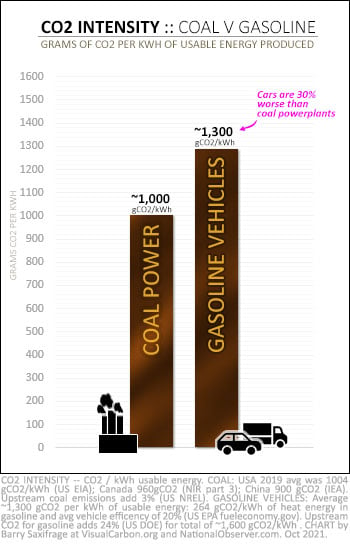
My first chart compares the CO2 intensity of coal power plants and gasoline-powered vehicles.
Coal power plants dump around 1,000 grams of CO2 out their smokestacks for every kilowatt-hour of usable energy they produce (gCO2/kWh).
Gasoline cars and trucks, in comparison, pump around 1,300 gCO2 out their tailpipes for every kWh of usable energy they produce. That's one-third more climate-polluting than coal power plants for the same amount of energy.
(Note: The values for the CO2 intensity of gasoline vehicles used in this article are the author's calculation based on data from the U.S. Environmental Protection Agency (EPA). For details on this and the other data used in this article, see the geeky endnotes.)
Half as efficient as coal power plants
The reason gasoline cars and trucks are so much more climate-polluting is that they are so much less efficient than coal power plants.
According to the EPA, car engines convert just one-fifth of the heat energy in gasoline into work energy that turns the wheels. The other four-fifths of the energy gets lost as waste heat and friction. Unfortunately, that's about as good as the laws of thermodynamics and real-world friction allow vehicle engines to be.
Coal power plants, in contrast, convert around two-fifths of the heat energy in coal into energy that can do work (electricity). They are twice as efficient as gasoline engines.
Put another way, gasoline vehicles need to burn a lot more fuel to produce the same amount of useful energy. That results in more emissions for the same energy.
Upstream emissions widen the gap
Gasoline has another big climate strike against it. Producing gasoline takes a lot more energy — and therefore causes more emissions — than producing coal. When these "upstream" production emissions are included, the climate pollution gap grows even wider.
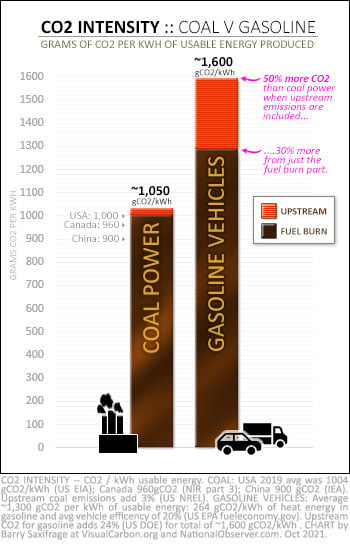
My next chart lets you see this by adding upstream emissions as orange bars.
Digging up coal increases its emissions by around three per cent. That doesn't change its overall CO2 intensity much.
Producing gasoline, however, adds around 24 per cent in extra emissions. That's eight times more upstream emissions than for coal.
As a result, the full "wells-to-wheels" CO2 intensity for gasoline cars and trucks jumps up to around 1,600 gCO2/kWh — 50 per cent higher than coal power plants.
In Canada, that gap is wider still. That's because our coal plants are a bit newer and cleaner than what I show on the chart, which is the American average. Canada's coal power averages around 960 gCO2/kWh. Newer coal technology is less CO2 intensive. For example, China's coal power — with lots of newer and higher-efficiency plants — averages 900 gCO2/kWh. And the very newest ultra-supercritical coal plants can now produce electricity at 750 gCO2/kWh. That's just half the CO2 intensity of today's gasoline vehicles.
If coal power plants are far too CO2-intensive for a safe and sane climate future, then the even more climate-damaging gasoline power plants in our vehicles are too.
Climate pollution trends in Canada
So far, we've looked at the CO2 intensity of coal power versus cars. Let's now look at the total climate pollution emitted by each in Canada.
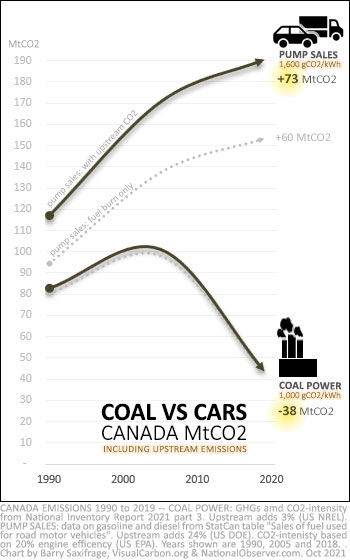
The good news, as my next chart shows, is that Canadians have been reducing total emissions from our coal power plants.
The lower black line shows that Canada's annual coal power plant emissions fell by 38 million tonnes of CO2 (MtCO2) since 1990. Shutting down coal power plants has been our one big climate success in Canada so far.
The bad news is that all our hard-won climate progress on coal pollution has been wiped out by our even larger surge of emissions out our tailpipes.
As the top black line on the chart shows, the climate pollution from the gasoline and diesel we pump into our cars and trucks has jumped by 73 MtCO2 per year since 1990. These pump sales include both passenger and freight vehicles.
So, for every coal power plant we've managed to close in Canada, we've opened the equivalent of two more — via the millions of gasoline power plants in our cars and trucks. To make matters worse, the new ones are even more CO2-intensive than the ones we closed.
One step forward and two steps back. It's no wonder Canada's emissions keep going up, up, up.
What's the alternative?
Powering vehicles with electricity
Powering vehicles of all shapes and sizes with Canadian electricity is less climate-polluting than burning gasoline. My next chart shows just how much less.
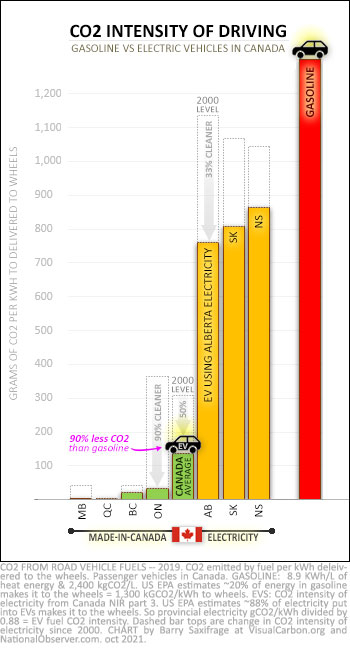
Gasoline is shown by the tall red bar. That's the CO2 intensity of 1,300 gCO2/kWh discussed above.
Compare that to the orange and green bars. They show the CO2 intensity of powering an electric vehicle (EV) with made-in-Canada electricity.
Let's start by looking at the tallest green bar with the little EV car on top. That shows the average for Canadian electricity. It powers an EV at around 135 gCO2 per kWh delivered to the wheels. That's 90 per cent less climate pollution than with gasoline.
As a climate bonus, Canadian electricity is getting cleaner every year. Gasoline isn't. The dashed boxes above the green and orange bars on the chart show how much cleaner each electricity supply has become since 2000.
For example, the dashed box above the green bar for Canadian average electricity shows that overall, the nation's electricity is 50 per cent less climate-polluting than in 2000. Ontario's electricity is now 90 per cent cleaner.
The remaining green bars show the CO2 intensity of driving on the electricity in Ontario, Quebec, B.C., and Manitoba. Eight out of 10 Canadians live in one of these super-clean electricity provinces. All of them have electricity that is at least 97 per cent less climate-polluting as a vehicle fuel than gasoline. In Quebec and Manitoba, electricity is 99.9 per cent cleaner than gasoline.
But even in the "dirty electricity" provinces shown by the orange bars — like Alberta, Saskatchewan, Nova Scotia — electricity is still significantly less climate-polluting than gasoline. And again, all those electricity supplies are getting cleaner.
The good news here is that Canada has some of the least climate-polluting electricity in the world. If we powered our vehicles with it — instead of gasoline — we'd also have one of the world's cleanest and climate-safest vehicle fleets in the world.
The bad news is that, so far, we are sticking with gasoline.
Lagging behind our peers
When Canadians go to buy a new car or truck, very few are choosing one that can be fuelled with climate-safer electricity.
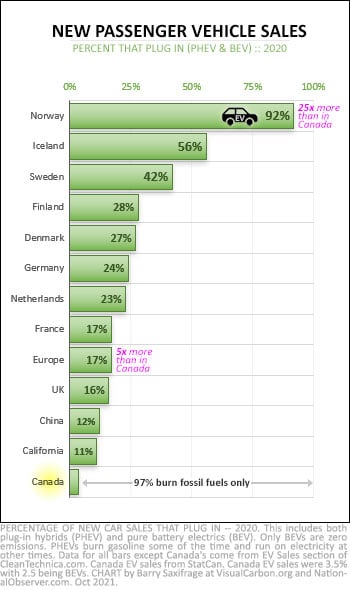
Last year, just three per cent of the new passenger vehicles bought by Canadians had a plug.
That's far fewer than our peers are buying in many other nations. The green bars on my chart show EV sales so far this year as reported by the ever-informative CleanTechnica.
Europeans overall are opting to buy electric-powered vehicles five times more often than Canadians are.
The Germans are choosing plug-ins for a quarter of their new cars. The Swedes are sprinting towards 50 per cent electric-powered.
And, famously, the Norwegians are now choosing EVs for more than 90 per cent of their new passenger vehicle purchases. They're a major oil-producing nation, on the scale of Alberta, and they are choosing the climate-safer electric power option nearly every time.
Canadians are doing just the opposite. We are choosing gasoline burners for 97 per cent of the new passenger vehicles we buy. Thirty years after we first promised to cut our oversized climate pollution, we still continue to drag our feet on choosing the climate-safer options that are right in front of us.
And while Canada is at the bottom of this particular list, there is another list where we are at the very top.
The world’s most climate-polluting cars and trucks
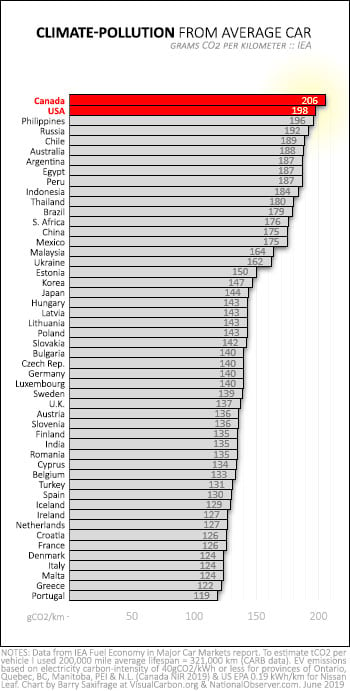
According to the International Energy Agency (IEA), Canadians are choosing to buy the world's most climate-polluting passenger vehicles.
Each one emits 206 gCO2 per kilometre, on average.
As the chart shows, Canadians are choosing to emit 20 per cent more climate pollution every kilometre than the Chinese are. That rises to a climate-hammering 50 per cent more CO2 every kilometre compared to the new cars bought by the British, French, and Germans.
As we saw at the top of this article, all gasoline cars and trucks emit more CO2 per unit of energy than coal power plants. What this IEA data shows is that Canadians are also choosing the gasoline vehicles that require the most energy to travel each kilometre. We are buying the world's biggest "coal plants" on wheels to get around.
Every minute, Canadians buy three more brand-new gasoline-burning passenger vehicles. Each one will go on to burn an average of 21 tonnes of gasoline, emitting 66 tonnes of CO2 out the tailpipe. These are locking in another million tonnes of future CO2 every three days. And all those new gas-burners will still be hyper-emitting with every kilometre well beyond 2030.
This is what climate failure looks like — locking in a transportation fleet that's even dirtier to use than coal power.
Why are we so out of control with our vehicle emissions in Canada? One big reason, as I covered in my last article, is that our federal and provincial governments have kept the price very low to climate-pollute out our tailpipes. Canadians pay far less in gas taxes than is the average across the OECD and G7 nations. In fact, Canadians pay hundreds of dollars less for each tonne of CO2 emitted out the tailpipe than our peers do in most of these other nations. And Canada's ballyhooed carbon tax — scheduled to rise to $170 per tonne of CO2 by 2030 — is far too tiny to bring us level with what most other nations charge in gasoline taxes today.
What all these charts and data make clear is that the gasoline we pump into our vehicles has been driving climate failure in Canada for decades now. And while we have a good alternative in low-CO2, made-in-Canada electricity to power our vehicles with, we're dragging our feet on switching to it. Instead, Canadians are still choosing — 97 per cent of the time — to buy the world's most climate-polluting option for our new cars and trucks.
Climate denial in Canada isn't something that only happens in the oilsands, pipeline, and fracking industries. It is also happening on our streets and in our garages all across the nation.
If we want to become climate leaders instead of perennial climate foot-draggers, Canadians will need to stop buying new dirtier-than-coal gasoline power plants every few seconds. These are driving us all right off the climate cliff.
-------------------------
The geeky endnotes.
For those wanting a deeper dive into the coal power and gasoline power calculations and data sources used in this article, here's the next level down that rabbit hole.
The CO2 intensity of gasoline power versus coal power — Gasoline is often thought of as less climate-polluting than coal because it emits less CO2 for each unit of heat energy that is given off when burned. And, indeed, coal is the more CO2-intensive fuel for heating.
But we don't burn gasoline for heating. What we really want from our gasoline is the power to move our cars. That's a more organized form of energy called "work energy." The electricity produced in coal power plants is also this same organized "work energy."
Unfortunately — as the chart below shows — gasoline power plants in vehicles are far less efficient than coal power plants at transforming the heat energy given off by burning fossil fuels into the work energy we need.
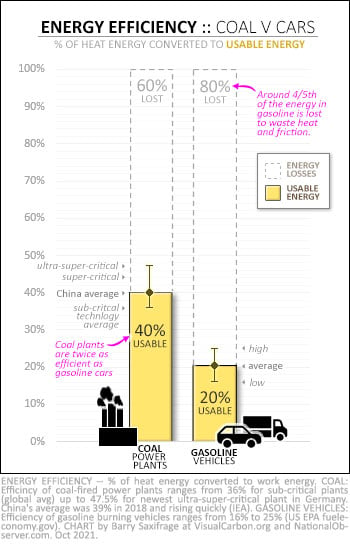
According to the EPA, gasoline engines only convert around 20 per cent of the heat energy into work energy (to turn wheels). This ranges from 16 per cent to 25 per cent depending on driving conditions. In this article, I used 20 per cent for the calculations and charts.
Coal power plants convert ~36 per cent to ~47 per cent of heat energy into work energy (electricity), depending on the technology. The global average for older, sub-critical plants is 36 per cent. The newer super-critical ones are around 44 per cent efficient. And the best new ultra-super-critical plants achieve 47 per cent. In this article, I used the real-world average for the U.S. of ~1,000 gCO2/kWh. That's at the low end of the range, at around 36 per cent.
Here are the data and calculations I used in the article:
Heat energy
- Gasoline: 252 gCO2 per kWh of heat energy (EPA).
- Coal: 340 gCO2 per kWh of heat energy (range 320 to 355: EPA).
Heat to work conversion efficiency
- Gasoline: 20 per cent.
- Coal: 36 per cent.
CO2 intensity for work energy produced
- Gasoline: 252 gCO2 / 20 per cent conversion = 1,261 gCO2 per kWh of work energy. I rounded this up to be ~1,300 in the article to provide a ballpark estimate that is easier to remember and compare.
- Coal: 340g / 36 per cent conversion = ~ 950 gCO2 per kWh of work energy. I also rounded this number up to ~1,000 for the same reasons of making it easier to remember and compare.
Diesel versus gasoline — In the article, I only discuss "gasoline" for simplicity and because 95 per cent of passenger vehicles in Canada burn gasoline. Diesel cars and trucks have a similar CO2 intensity as gasoline cars.
It is often noted that diesel engines can be a bit less CO2-intensive than gasoline engines. But studies of real-world driving show most or all of this benefit gets lost before getting to the wheels. For example, this study by the International Council on Clean Transportation (ICCT) concluded: "A modern gasoline vehicle can have the same or even lower CO2 emissions than a comparable diesel version."
One big reason is that diesel vehicles require a lot of extra energy to filter out the higher levels of NOx gases. Trying to avoid that energy penalty was the motivation behind the Dieselgate emissions cheating scandal by VW and others. In addition, diesel vehicles are often heavier and have more powerful engines, further eroding the real-world efficiency for them.
Upstream emissions — Upstream emissions are emitted during the extracting, refining, and transporting of coal and gasoline. Here are the values I used in my calculations and charts:
- Coal three per cent — this was an average from the "Life Cycle Assessment of Coal-fired Power Production" (pdf) by the United States National Renewable Energy Laboratory (NREL).
- Gasoline 24 per cent — according to NREL studies I read, it ranges from 20 per cent to 30 per cent with the average around 24 per cent. For an overview, see "Cradle‐to‐Grave Life Cycle Analysis of Conventional Petroleum Fuels." (pdf)
- Canadian electricity supplies — I couldn't find information on upstream emissions for each province's electricity generation. So, my charts and discussions of gasoline versus Canadian electricity only cover the emissions from direct burning of gasoline in cars and from directly producing electricity.
CO2 efficiency of electric-powered vehicles — Here are some key stats and calculations I used in the article and charts:
- 88 per cent energy efficiency — the EPA publishes excellent graphics detailing the energy efficiency of electricity-powered cars. For every 100 kWh of electricity put into an EV, around 88 kWh makes it to the wheels (range: 86 to 90). In comparison, only 20 out of every 100 kWh in gasoline make it to the wheels. That means, EV owners only need to buy a quarter as much fuel energy as gasoline car owners do. This dramatically cuts energy demand and fuel bills.
- CO2 intensity of electricity production — the CO2 intensity of each province's electricity is published in Canada's National Inventory Report, Part 3.
- CO2 intensity of electricity as vehicle fuel — I calculated this by dividing the CO2 intensity of the electricity supply by the 88 per cent energy efficiency of EVs. For example, Ontario electricity is listed at 30 gCO2/kWh. The math for an 88 per cent efficient EV powered by that is: 30 gCO2 per kWh / 0.88 efficient = 34 gCO2 per kWh that makes it to the wheels.
Producing electric vehicles
Producing electric vehicles have their own environmental impacts. In the 1990's researchers at the Wuppertal Institute in Germany developed a way to calculate the amount of resources you need to manufacture a product or provide services. It's called an MIPS or "material input per service unit".
The MIPS evaluates the total of resources needed and displaced for the manufacturing, the use and the recycling of a piece of clothing, a bottle of orange juice, a carpet, a smartphone....
For example, a 2 kilograms (kg) computer will use 22 kg of chemical products, 240 kg of fossil energy and 1.5 tons of clear water. The MIPS of a television stands between 200 and 1000/1, while a smartphone is around 1,200/1 (183 kg of raw materials for a 150 grams of finished product).
But it's the microchip that has the highest MIPS with "32 kg of raw material" to produce a "2 grams" microchip that is used in hundreds of different products including cars.
For example, a standard gas powered Ford Focus has around 300 microchips while the new all electric Ford Focus counts more than 3,000 microchips. Think about the impacts on the environment.
I am not against the production of electric cars, but the impacts on the environment will be quite substantial, notwithstanding that it will not solve traffic congestion, expansion of suburbs (destroying good agricultural land), construction of roads and infrastructures, recycling of batteries and other materials involved in production of cars. Electric vehicles need tires. Most people don't realize that the wear of tires released tons of toxic fine particules that pollutes the environment, can infiltrate your lungs and affect your health.
Getting rid of cars (especially gas guzzling vehicles like big SUVs and pickup trucks which are mostly responsible for the increase of emissions in the transportation sector around the world), is probably an impossible task when we all know how people are addicted to their cars, even when you offer them more economical, easy to use and more environmentally friendly ways of transportation. But I think that encouraging people to buy electric vehicles won't solve the main problem which is the overconsumption of everything. We have to learn to live with less. New technologies won't give us enough time to avoid the worst environmental impacts caused by climate change, which is the result of our insatiable need for consumption.
You're talking about maybe
You're talking about maybe three different problems, though.
1. Should people be buying as many cars? No, almost certainly not. Both because consumerism is out of control, and because lots of mass transit is a really good idea for a host of reasons.
But that isn't an argument against electric cars. I don't see the car disappearing, and I'm not convinced it should. There is a place for individual vehicles individually controlled. Even if it was all car-sharing stuff, they'd still be cars. So, if a car exists, what kind should it be? Electric.
2. Does industry burn too much carbon in producing things, including cars whether electric or otherwise? Certainly. Industry should be electrified more, and the electricity supply should not be provided by burning carbon.
But that's not an argument against electric cars, either. And both the electricity supply and electrification of industry are being addressed. The more they are, the less production of any car will emit carbon. In the slightly longer game, producing electric or ICE cars will emit less carbon, but driving ICE cars will still emit the same amount, whereas driving electric cars will produce less and less, and in ever more places, none.
Admittedly in the even longer game, climate change is far from our only environmental disaster. There are too many of us and, in the first world certainly, we each use too much stuff.
3. People using big cars is the problem, and this is intractable because people want what they want and can't be made to want alternatives. Well, it's a problem, but it's clearly not all that intractable. People's tastes in cars are to a big extent shaped by advertising. And car manufacturers have an interest in advertising cars they sell at big margins. So they do. So it's not like everyone instinctively wants an SUV or a jacked up ridiculous chrome-y nobody-would-ever-use-this-for-work pickup. They want them because the ads make them associate those things with Freedom and Escape and superpowers like the ability to drive up vertical cliffs. But these tendencies can clearly be overridden by economic considerations, like very expensive fuel in much of Europe, and robust incentive structures in Norway. You could also legislate no advertising gas-guzzlers, or tax car companies more the more resource-hungry their vehicles were.
"Gasoline cars and trucks, in
"Gasoline cars and trucks, in comparison, pump around 1,300 gCO2 out their tailpipes for every kWh of usable energy they produce."
At rush hour, freeways turn into parking lots. Many people idle their vehicles, especially in winter.
For the amount of actual useful work they do, ICE vehicles are even more inefficient.
Canada's transportation sector emissions have increased 54% since 1990.
Canada's oil & gas sector nominal (grossly under-reported) emissions have increased 87% since 1990.
The oilsands is the fastest growing source of emissions in the country. Upstream O&G is the highest emitting sector in Canada, ahead of transportation.
Conclusion: Canada's oil & gas sector is an even bigger climate culprit.
Yes, vehicles are a big part
Yes, vehicles are a big part of Canada's emissions problem — but the proposed solution is not sustainable either.
We need to minimize the role of EVs (private cars) and maximize the role of public transit.
While EVs are far more efficient, and infinitely preferable in terms of air pollution, EVs are not a green solution.
EVs have a huge footprint. Car culture drives urban sprawl. Neither is remotely sustainable.
With their huge footprint, EVs wouldn't be green even if they ran on fairy dust. Much of that footprint is embedded in mining and manufacture of materials. About half of the energy used over the lifespan of a car is expended during its production. Using two tons of metal to transport a 150 lb human being is an ecological non-starter.
Halving our emissions but doubling the number of cars (in developing world) gets us precisely nowhere.
*
Cars drive sprawl, and sprawl drives cars. Sprawl forces people to drive everywhere they go. Once people get in that habit, it's hard to break. Obscene energy expenditure. Lost productivity, sedentary lifestyle (and health problems), millions of deaths and injuries, roadkill, and social isolation. Disintegration of community, loss of green space, endless freeways and traffic jams, inefficient public transit, lost productivity, strip mall blight, mega-mall culture, parking lot proliferation, accidents, and property damage. Insanely long commutes in bumper-to-bumper traffic. Sprawl multiplies congestion, energy consumption and waste, time and productivity loss, emissions, and footprint.
In perpetuating sprawl, EVs exacerbate the problem and obstruct real solutions. A one-Earth footprint cannot accommodate an energy-intensive lifestyle where people drive everywhere they go -- or an urban model relying on millions of cars to transport millions of people.
Sprawl makes efficient public transit impossible. In perpetuating sprawl, EVs obstruct the problem and delay real solutions.
EVs support the unsustainable urban model underlying our high energy/resource consumption. We cannot solve the paradigm problem simply by replacing internal combustion engines with electric motors.
No solution to sprawl except to hit the brakes. The decisions we make now set the blueprint for generations to come.
Merely switching to EVs replaces one environmental disaster with another.
In my commentary, I forgot to
In my commentary, I forgot to put the MIPS for microchips which is " 16,000/1 " compared to a smartphone which is 1,200/1. Talking about the wear and tear of tires, I forgot to mention that electric vehicles are heavier than their gas powered equivalent and then caused tires to wear more rapidly. Since they are heavier vehicles, they will cause roads to deteriorate more rapidly on the long term.
I cannot disagree with
I cannot disagree with Geoffrey Pounder or Rene Ebacher. Their arguments are sound. I still think they miss that we are here, now. I live 30 km from the nearest town in west central B.C. I would like to have an electric van go up and down the rural gravel road where I live three times a day, collecting people at their driveways. I would like that van to connect to a twinned and electrified CN mainline that runs several local and long distance trains every day. Convenient, less polluting, and less cost to society that the ICE regime we have now. But that is not where we are.
I built a solar array four years ago and bought a small EV (Bolt) three years ago. It cost a lot of money, but now it saves me a lot of money, every month.
It is also quiet and does not stink. Can you imagine how much better life would be in the city if all vehicles were electric? The reduction in noise, toxic exhaust, and brake dust? Cities would be much more livable. There would be much less pollution. And the total energy required for transportation would plummet by four fifths.
Yes, electric vehicles are not the solution. But they work, now, and make life easier for people, and the environment. I don't know how to address the need to switch the entire transportation system. Maybe automatic vehicles that come when needed could help. Where we are now, it is lower hanging fruit, particularly for people like me who are very poorly served by public transit, to buy an individual EV. But Geoffrey and Rene are still right.
I know that it is difficult,
I know that it is difficult, almost impossible, for people living outside large urban areas where municipalities can provide good public transportation options (hopefully being more and more electrified) to switch to more environmentally ways of transportation.
I lived in Toronto and have easy access to public transportation. In 2007, after a minor accident, I had to get rid of my old car. At that point, I asked myself (and my wife obviously) if we could manage without a car. We never regretted the decision. We walk more, bicycle and just rent a car when we have to go out of town, and saved a lot of money.
We have a cabin up north with no electricity and there is no place (yet) where we can recharge an electric vehicle. That's why we have to rent a regular combustion engine gas powered vehicle ( I've never been able to rent a hybrid, even less an electric vehicle). Electricity rates are also higher in rural areas which makes things even harder for people to switch to hybrid or fully electric vehicles.
I don't blame people living in rural areas for using combustion engine vehicles, but I don't understand people living in big cities buying big gas guzzling SUV's and pickup trucks which are in large part responsible for the increase in GHG emissions in the transportation sector in Canada, and around the world ( in a 2019 study, the International Energy Agency (IEA) calculated that if all GHG emissions from the over 200,000,000 SUVs around the world were put together, it would be, as a country, the 7th largest emitter in the world).
In short, people mostly make
In short, people mostly make terrible (for the climate) choices to provide themselves with a little more convenience or perceived safety from a large vehicle. Engineers laboured long into nights, making the internal combustion engine about 30% more efficient since the 70s Arab Oil Crisis...and we responded by shifting our purchases to vehicles that weigh 30% more. "Thanks for your efforts, we'll take them all for ourselves".
All we can do is twist their arms with taxes on the consumption.
While there are many benefits
While there are many benefits of battery electric vehicles, there are a few critical gaps that must be resolved by 2030 or so, if we want to have a realistic shot at 100% ZEVs by 2035.
1. There are no battery disposal regulations. In a few years, a huge number of batteries will reach end of life when the salvaged materials cannot be reused in other batteries. I sincerely hope that in our zeal for BEVs, we do not end up creating the same mistakes that resulted in orphan oil and gas wells, fugitive methane emissions, and plastics in the oceans.
2. About half of urban population lives in condos. There are 1.5m condo residents in Metro Vancouver alone. A majority of these live in high-rises without access to fast chargers. BEVs are not an option for this vast group of emitters.
3. Public transit cannot reach large chunks of urban areas. Rideshare vehicles are growing to fill this gap. Due to their heavy utilization, and the need for fast charging (every minute spent charging the battery during the day means lost business), BEVs are not an option for this fast growing group of emitters.






Comments